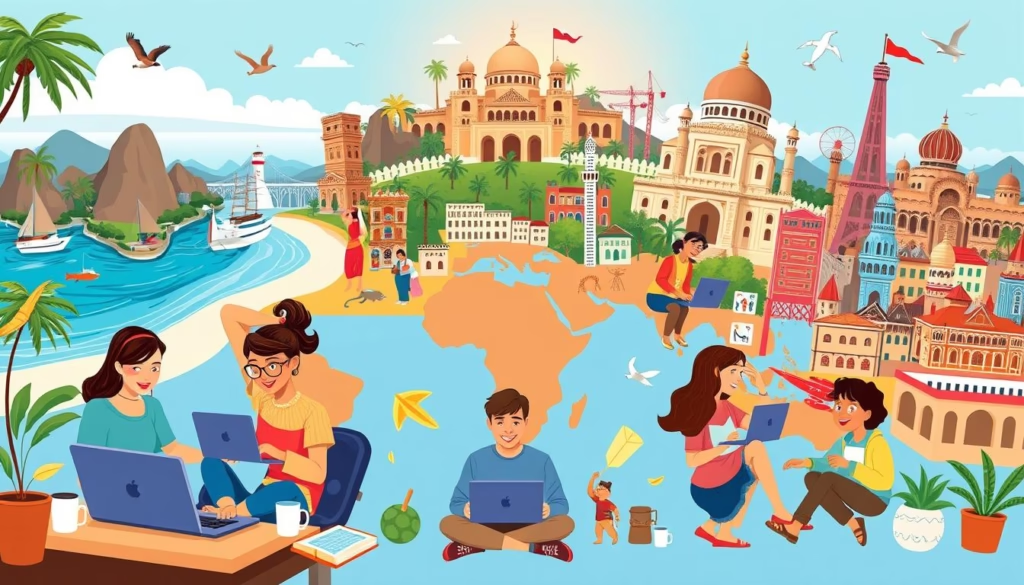Countries for Digital Nomads: How to Choose the Right Destination
December 28, 2024 | by m33559844@gmail.com

introduction: Countries for Digital Nomads
Imagine waking up to the sun and the smell of coffee. You have the freedom to work on a beach in Bali or at a café in Lisbon. The digital nomad lifestyle is a dream for many, blending work and travel. It opens doors to new cultures and experiences.
Today, over 40 countries offer visas for digital nomads. This makes it easier to find the best places for remote work and escape the office1.
As more people start this journey, knowing how to live abroad is key. You need to pick a place that fits your budget and lifestyle. You also have to meet visa requirements. This article will help you choose the perfect spot for your remote work adventures. It will empower you to enjoy this flexible lifestyle fully2.
Key Takeaways
- Over 40 countries now provide digital nomad visas, expanding your location options.
- Understanding visa requirements is key for a smooth transition.
- Budgeting for living costs and taxes is vital when picking a destination.
- Researching cultural experiences can make your travel better.
- Choosing where to work allows for a richer life experience.
If you’re ready to kickstart your travel journey with ease and exclusive savings, book your first trip now! Visit Trip.com using this special promotion link and register to reserve tickets, accommodation, and more. Don’t miss out on these incredible travel deals tailored for first-time travelers—start planning today!
Understanding the Digital Nomad Lifestyle
The digital nomad lifestyle is a big change in how we work and travel. Over 60 million people worldwide now live this way, thanks to more remote work after Covid-193. It’s popular among freelancers, remote workers, and entrepreneurs who love flexibility and exploring new places4. The key is being able to work from anywhere with good internet4.
Many digital nomads like cities, like capital cities, for their good internet and coworking spaces4. They try to keep a routine while traveling to stay productive4. They also save money by living in places with lower costs, then earning more in wealthier countries4.
Studies show working in comfy spots boosts productivity3. But, this lifestyle can also bring money worries, like budgeting and income ups and downs3. So, it’s important to plan finances well and pick places that are good for digital nomads, like low costs and community support3.
Digital nomads face a thrilling but tough world. Choosing the right places means looking at laws, taxes, and what’s needed for living abroad5. As more people join this trend, knowing about remote work helps make a lasting life on the move5.
What is a Digital Nomad Visa?
A digital nomad visa lets remote workers stay and work in foreign countries legally for a long time. It can last from six months to two years, with some options for up to five years6. Unlike tourist visas, these are made for people who work remotely7.
Now, 67 countries offer digital nomad visas, thanks to the rise of remote work during the COVID-19 pandemic8. Places like Spain, Croatia, the UAE, and Argentina are popular. Each has its own rules, like minimum income and proof of work67. For example, Spain needs a monthly income of €2,268 and proof of work for three months before applying7.
The application process varies by country, taking about one month on average6. The cost to get a digital nomad visa can be from $100 to $3,000, depending on the country and situation8. Sometimes, family members can be included in the application, but there are limits6.
Applicants need to know the rules for these remote work permits. They must show they can support themselves while abroad7. It’s key to understand the visa rules of the countries you’re interested in. This way, you can fully enjoy the digital nomad lifestyle.
Benefits of a Digital Nomad Visa
A digital nomad visa offers many perks for remote workers. It lets them stay longer, often up to two years or more. This is great for getting to know a place better and balancing work and life.
Extended Stay Opportunities
Places like Spain and the Czech Republic are great for digital nomads. Spain’s visa needs a monthly income of €2,000 and offers a 15% tax rate for four years9. The Czech Republic’s visa doesn’t check income but wants you to have €5,600 for living costs9. These deals are perfect for those wanting to stay longer.
Tax Benefits and Financial Considerations
Taxes are key when thinking about tax benefits for remote workers. Countries like Barbados don’t tax income from abroad if you earn $50,000 a year9. Greece gives a 50% tax cut for seven years if you make €3,500 monthly9. Spain and Portugal also have good tax rates, making them good choices for remote workers. These financial perks are important when deciding where to go.
Digital nomad visas make life better and offer financial gains. As more places offer remote work programs, knowing these benefits is key for those thinking about it10.
Countries for Digital Nomads: Key Factors to Consider
Choosing the right country as a digital nomad is a big decision. Each place has its own good and bad points for remote work. Knowing these can help make sure you have a great and productive life abroad.
Internet Speed and Connectivity
Fast and reliable internet is key for digital nomads. Places with high-speed internet make work easier and less frustrating. Spain and Portugal are popular because they offer good internet speeds.
Co-working Spaces Availability
Having access to co-working spaces is important. These spaces help you work well and meet others who work remotely. Cities like Berlin and Barcelona have many co-working options for different budgets and tastes.
Safety and Security
Choosing a safe place is a must. Look at local safety, crime rates, and healthcare. Norway is safe and has good healthcare, making it a great choice.
Cost of Living Affordability
It’s important to think about how much things cost in a country. Costs for living can be different in each place. For example, Portugal and Spain need about €2,160 to €2,300 a month, but Costa Rica might need more than $2,500. This shows how costs vary111213.
| Country | Average Monthly Income Requirement | Internet Speed | Co-working Spaces | Safety Rating |
|---|---|---|---|---|
| Spain | €2,160 | High | Abundant | Very Safe |
| Portugal | €2,300 | High | Numerous | Very Safe |
| Costa Rica | $2,500 | Moderate | Growing | Safe |
| Germany | Varies | High | Widely Available | Very Safe |
Top Digital Nomad Destinations Around the World
Choosing the right place as a digital nomad can really boost your remote work experience. Many are looking for the best spots that offer great internet, lively culture, and friendly communities. Let’s dive into some top countries that are perfect for remote workers.
Countries for Digital Nomads : Popular Digital Nomad Countries in Europe
Europe has many great places for remote work. Spain is a top choice with a score of 4.50 on the Digital Nomad Visa Index14. It has a low tax rate of 15% for digital nomads and offers exciting cities and culture. Portugal and Greece are also popular, thanks to their good visa rules and lifestyle choices.
Countries for Digital Nomads : Digital Nomad Hotspots in Asia
Asia is home to Thailand and Indonesia, two big digital nomad spots. Thailand’s warm weather and beautiful scenery make it great for long stays15. Bali is a favorite for its beaches and workspaces. Malaysia and Vietnam are also gaining fans for their affordable living and rich cultures.
Emerging Remote Work Destinations in South America
South America is becoming a hotspot for remote workers. Countries like Colombia and Costa Rica offer great communities, beautiful landscapes, and friendly vibes. Colombia is known for its vibrant culture and growing infrastructure. Costa Rica is perfect for nature lovers and those who prefer a relaxed pace. Both countries meet the needs of remote workers well.
Evaluating Work-Friendly Countries
It’s key to know what makes a country good for digital nomads. The essential amenities for digital nomads are at the heart of this. Fast internet, comfy cafes, and places for meetings and printing are important. These things help you work better and enjoy your time more.
Essential Amenities for Remote Workers
When picking a country, think about what digital nomads need. A great place for remote work should have:
- Fast and reliable internet
- Cafes and workspaces for remote workers
- Places for printing and meetings
- Places to meet and work together
Many countries look at these things to attract digital nomads. The Global Digital Nomad Report looked at 65 countries to find the best places for remote work. This shows how much people want good places to work from16.
Local Networking Opportunities
Networking is also very important for remote workers. Local events and groups can make your experience better. Joining Facebook groups or Meetup can help you meet people and learn new things. Being part of local business groups or attending workshops can lead to great connections and knowledge sharing. This is why 91% of digital nomad programs started after 2020, showing a growing community of remote workers16.

If you’re ready to kickstart your travel journey with ease and exclusive savings, book your first trip now! Visit Trip.com using this special promotion link and register to reserve tickets, accommodation, and more. Don’t miss out on these incredible travel deals tailored for first-time travelers—start planning today!
Analyzing the Best Countries for Remote Work
When looking at the best countries for digital nomads, several factors matter. These include healthcare, climate, and environmental quality. Countries that focus on these areas offer a better life for remote workers. With 35 million digital nomads worldwide in 2023, this number is expected to hit one billion by 2035. This shows a growing interest in places that improve lifestyle and work productivity17.
Countries for Digital Nomads : Quality of Life Metrics
Quality of life for digital nomads covers many areas. For example, Portugal has fast internet, making it great for remote work. Its cost of living is 73.0. On the other hand, Thailand is cheaper, with a cost of living index of 34.7, and fast internet too17.
Urban areas in Estonia also appeal, with a living index of 96.58 and good internet17.
Cultural and Recreational Activities
Cultural activities are key for digital nomads. Portugal has a rich history and arts scene, with many music festivals. Thailand offers outdoor adventures, historical temples, and local markets. These activities help remote workers make lasting memories while working.
| Country | Cost of Living Index | Average Internet Speed (Mbps) | Digital Nomad Visa Income Requirement |
|---|---|---|---|
| Portugal | 73.0 | 205.11 | €2,800 |
| Thailand | 34.7 | 260.54 | $1,475–$5,900 |
| Estonia | 96.58 | 103.48 | €3,504 |
| Mexico | 58.5 | 77.07 | $1,620 |
| Costa Rica | 59.4 | 91.08 | $3,000 |
Finding Your Ideal Place as a Digital Nomad
Choosing the right location for your digital nomad lifestyle is important. You need to think about climate, lifestyle, and social opportunities. Also, researching expat communities can help a lot, as they offer support and insights.
Countries for Digital Nomads : Identifying Personal Preferences
Knowing what you prefer is key in finding a digital nomad destination. Over 15 years of experience show that everyone’s needs are different. Some prefer places like Oaxaca, Mexico, and Medellín, Colombia, for their cost and culture.
Cities like Berlin, Germany, and Austin, USA, are also favorites. They have great coworking spaces and reliable internet. This helps keep a good balance between work and life18.
Countries for Digital Nomads : Researching Local Communities
Looking into expat communities helps you find places with like-minded people. This makes moving easier and more fun. Cities like Chiang Mai, Thailand, and Tbilisi, Georgia, are great for this.
Coworking spaces and cafes are where digital nomads meet and make friends. They offer fast Wi-Fi, affordable living, and fun activities. This mix is key for staying motivated and happy19.

Legal and Administrative Considerations
It’s key for digital nomads to know the legal basics when starting remote work in a new place. This means understanding visa rules and what’s needed for remote worker residency. You’ll need to gather lots of documents for this.
Countries for Digital Nomads : Visa Application Procedures
Getting a visa requires the right documents, as rules change by country. Estonia, for example, needs a monthly income of €3,800 and a remote job contract for its Digital Nomad Visa. This visa takes 15 to 30 days to process20.
Croatia has a digital nomad visa with costs from $66 to $370. It lets you stay up to a year, with internet speeds of 46.53 Mbps fixed20. Greece’s visa costs $82 and lets you stay two years, needing a monthly income of $3,83020.
Countries for Digital Nomads : Understanding Residency Requirements
Remote workers need to show income, where they live, and health insurance for residency. Countries have their own rules for this. The Czech Republic, for instance, wants proof of skills and a monthly income of about $5,650 for its freelancer visa20.
It’s vital to have global health insurance, as local plans might not cover everything21. Doing thorough research helps meet local laws and avoid legal issues22.
Country-Specific Digital Nomad Programs
Many countries have created country-specific digital nomad programs to attract remote workers. Over 58 countries now offer digital nomad visa options. This means remote workers can explore new places and cultures while working23. Countries like Portugal, Spain, and Croatia have special visas for digital nomads to live there.
Portugal’s Temporary-Stay Visa needs a monthly income of at least $2,950 and costs about $19024. Spain’s digital nomad visa is around $265 and requires a monthly income of $2,21524. Croatia’s Digital Nomad Residence Permit costs $73 and needs a monthly income of at least $2,65824.
North America, like Costa Rica and Mexico, also offers great options for remote workers. Costa Rica is known for its beauty and welcoming culture. Mexico has vibrant cities and various permits for remote work. The Caribbean, with Barbados and Antigua & Barbuda, is also joining the digital nomad trend.
These programs for remote workers let people live abroad and work legally. For example, Georgia requires a monthly income of $2,000 or a bank statement of $24,00023. This ensures remote workers are financially stable while traveling.

If you’re ready to kickstart your travel journey with ease and exclusive savings, book your first trip now! Visit Trip.com using this special promotion link and register to reserve tickets, accommodation, and more. Don’t miss out on these incredible travel deals tailored for first-time travelers—start planning today!
With more country-specific digital nomad programs, aspiring digital nomads have many choices. These options cater to different lifestyles and work needs. The rise of digital nomad visas shows how remote work is changing where and how we work.
| Country | Visa Cost | Minimum Monthly Income | Notes |
|---|---|---|---|
| Portugal | $190 | $2,950 | Temporary-Stay Visa |
| Spain | $265 | $2,215 | Digital Nomad Visa |
| Croatia | $73 | $2,658 | Digital Nomad Residence Permit |
| Georgia | Varies | $2,000 | Proof of income required |
Knowing about these country-specific digital nomad programs helps navigate remote work. It offers clarity and direction for those wanting to live and work abroad24.
Future Trends and Developments in Digital Nomadism
The world of digital nomadism is changing fast. New remote work rules and tech advances are leading the way. For those looking to join this lifestyle, it’s key to understand these changes.
In 2020, the U.S. saw a 50% jump in digital nomads to 11 million. By 2021, this number grew to 15.5 million. Now, over 16.9 million digital nomads work globally, with 52% from the U.S25..
Countries for Digital Nomads : Impact of Remote Work Policies
A FlexJobs survey found 58% of workers can work remotely part-time in 2024. This is up from 44% in 2022. Countries like Portugal, Estonia, and Barbados are welcoming digital nomads with special visas26.
By 2024, coworking spaces are expected to grow by 20% worldwide. This will help remote workers find better places to work26.
Next Steps for Aspiring Digital Nomads
Aspiring digital nomads should start by finding remote work and researching places to go. Mental health support is key, with 75% of remote workers saying it’s vital26.
It’s important to get involved in local communities. Places like Chiang Mai and Da Nang offer great cultures and affordable living25.
| Destination | Cost of Living | Community Vibe |
|---|---|---|
| Chiang Mai, Thailand | Low | Cultural festivals & community |
| Lisbon, Portugal | Moderate | Welcoming |
| Medellin, Colombia | Low | Safe & vibrant |
| Tbilisi, Georgia | Low | Emerging hotspot |
| Da Nang, Vietnam | Low | Relaxed beach vibe |
| Playa del Carmen, Mexico | Low | Relaxed atmosphere |
These places and platforms are perfect for digital nomads. They offer great work environments and a chance to connect with the world.
Conclusion
Digital nomadism offers a unique chance for remote workers to travel and grow professionally. The future looks bright for digital nomads as more countries welcome them with digital nomad visas. When picking a place to live and work, consider internet, cost of living, and local culture.
There are about 35 million digital nomads worldwide, mostly young professionals. Making smart choices based on data is key to a happy life abroad2728.
Digital Nomad Visa: How to Apply and What You Need to Know . By carefully choosing where to go, you can make the most of your experience and career goals. The world is changing, and being open to new places can lead to exciting, fulfilling lives.
FAQ : Countries for Digital Nomads
What are the best countries for digital nomads?
The top countries for digital nomads depend on what you like. Portugal, Spain, Thailand, and Costa Rica are favorites. They have great internet, lively cultures, and good visa rules.
What is a digital nomad visa?
A digital nomad visa lets remote workers live and work abroad. It’s a temporary work permit that can last from six months to two years.
How can I find suitable work-friendly countries?
Look for countries with fast internet, co-working spaces, and safety. Also, think about the cost of living. Join local groups and network to learn more.
Are there specific requirements for obtaining a digital nomad visa?
Yes, you need proof of remote work, health insurance, and sometimes a minimum income. Each country has its own rules.
What are the benefits of living as a digital nomad?
Digital nomadism lets you work while traveling. It’s a chance to dive into new cultures and might save you on taxes.
How do I evaluate the cost of living in digital nomad destinations?
Compare housing, transport, and daily costs like food and fun. Use online tools and forums to see what others spend.
What should I know about networking opportunities for digital nomads?
Digital nomads can meet at local events, online groups, and coworking spaces. These help you make friends and professional contacts.
What trends are shaping the future of digital nomadism?
Digital nomadism is changing with new remote work rules and tech. Coworking spaces are growing, creating places for digital nomads to work together.
Where can I learn more about country-specific digital nomad programs?
Look on government websites or remote work platforms. Check each program’s rules and benefits to see if it’s right for you.
RELATED POSTS
View all



